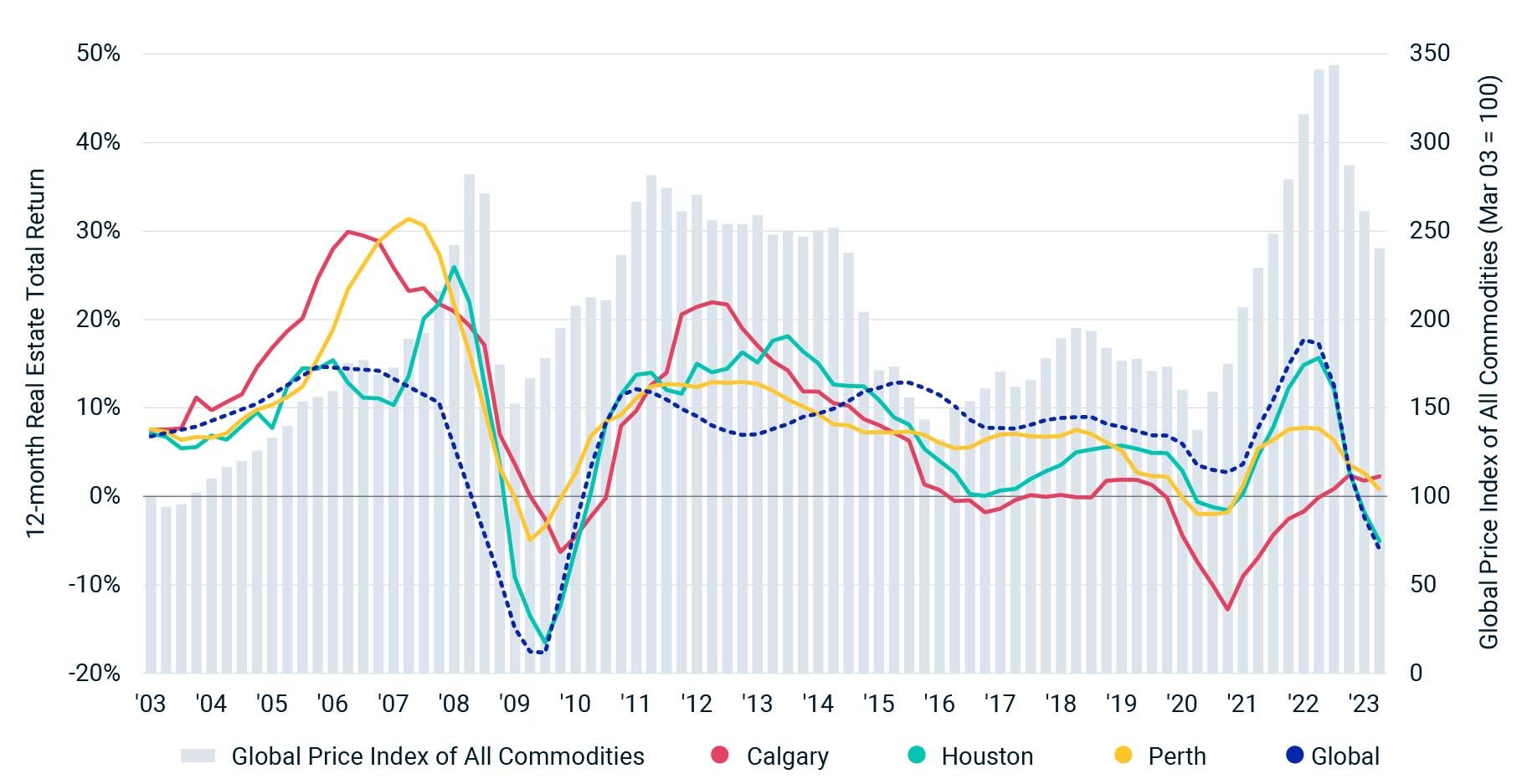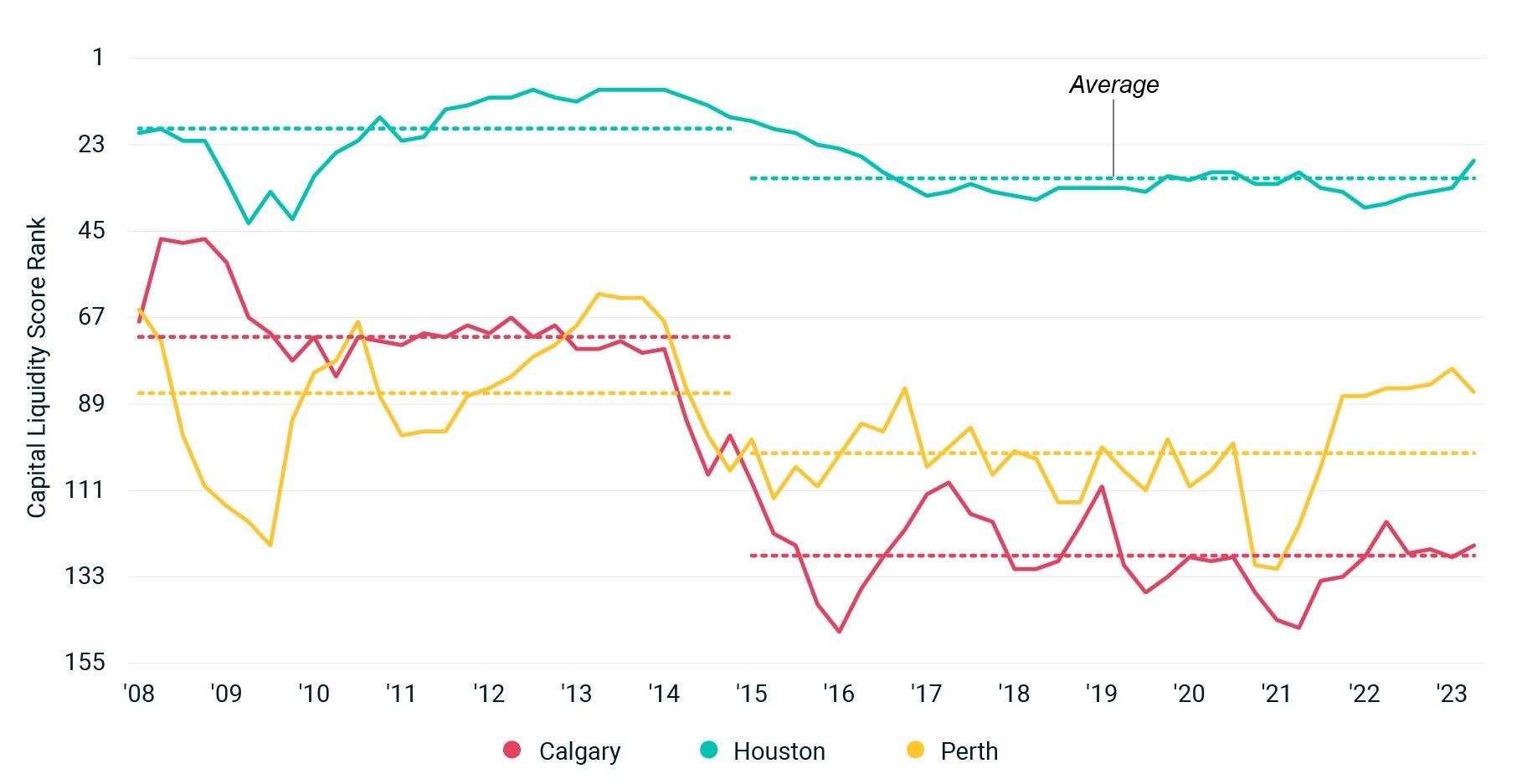Unearthing Real Estate Trends in Commodity Cities
Key findings
- Cities that ride booms and busts in commodity prices achieved strong outperformance in total returns during the last boom in commodities, but returns have been less sensitive to surging prices in recent years.
- Oversupply in the aftermath of the last commodities boom, together with lower investor appetite, has translated into weaker returns more recently for Houston, Perth and Calgary despite a surge in commodity prices.
- While positive trends have emerged in very recent quarters, commodity cities like most markets face headwinds such as higher borrowing costs and uncertainty around remote work.
A boom in commodity prices in the 2000s and early 2010s helped drive strong investment performance for commercial real estate in markets like Calgary, Houston and Perth as investment in oil, gas and mining flourished. But performance suffered after the commodity bubble burst in 2014, and even a recent pandemic-fueled surge in commodity prices has not translated into the same kind of strong outperformance seen during the last cycle.
Returns have been less sensitive to commodity prices in recent years

Source: International Monetary Fund, MSCI Global Annual Property Index (for global data before 2008), MSCI Global Quarterly Property Index, MSCI U.S. Quarterly Property Index, MSCI/REALPAC Canada Annual Property Index, The Property Council of Australia/MSCI Australia Annual Property Index
What is different this cycle?
Part of the explanation for this weaker performance lies in basic economics and the laws of supply and demand. One driver boosting returns during the last cycle was lower-than-average vacancy rates (see the exhibit below). As mining, oil and gas companies expanded to meet increases in demand for products, their need for commercial real estate increased. As they expanded and hired more people, this created a multiplier effect in local economies. Inelastic supply and lower vacancy rates combined to drive strong rental growth, which in turn helped boost investment returns. But as with many booms, construction activity also increased as developers sought to capitalize on strong rent growth.
So, what changed? When the commodities bubble burst in 2014, there was a pronounced spillover effect on investment and employment in industries involving resources. It precipitated a reduction in demand for space, which, combined with the increase in supply, put upward pressure on vacancy rates and downward pressure on rental growth. This acted as a drag on return performance and, by 2015, Calgary, Houston and Perth were underperforming the MSCI Global Quarterly Property Index.
Vacancy rates in commodity cities have climbed while global vacancy rates have fallen

Source: MSCI Global Quarterly Property Index, MSCI U.S. Quarterly Property Index, MSCI/REALPAC Canada Annual Property Index, The Property Council of Australia/MSCI Australia Annual Property Index
Underperformance has largely persisted, with an overhang of excess supply (particularly for offices) weighing on performance. Events like Hurricane Harvey in Houston have caused additional headwinds. As returns have softened, so has investor appetite in these markets and transaction activity has ebbed. MSCI Capital Liquidity Scores, which measure the depth and breadth of capital active in global real estate markets, provide one illustration of this retreat.[1]
Ranking the scores of the 155 markets tracked by MSCI Capital Liquidity Scores, we see a notable drop when comparing 2008-14 to 2015 onward. Calgary's average rank in these two periods dropped from 72 to 128, Houston's fell from 19 to 32 and Perth's average rank fell from 86 to 102, as institutional investors turned to other markets in the wake of the bubble.
Capital-market liquidity has retreated relative to other markets

Source: MSCI Capital Liquidity Scores
Even though commodity prices have rebounded through the pandemic, excess supply and memories of the last boom have meant that the impact on commercial real estate has been much more limited.
Positives and challenges
While returns have not surged, the gap between the returns in commodity cities and other markets has narrowed in recent quarters, and some outperformance has returned. By the end of June, annual total returns stood at -6.0% globally compared to 2.3% for Calgary, -5.1% for Houston and 0.8% for Perth. Vacancy rates have been trending down in recent years from the highs in 2021, while still remaining elevated — particularly in offices.
These positives are counterbalanced by some of the headwinds facing commercial real estate more broadly, however. Higher borrowing costs, uncertainty around remote work and the continued evolution of online shopping are all factors that could cast a shadow over real estate markets, including those of commodity cities.
Subscribe todayto have insights delivered to your inbox.
1 MSCI Capital Liquidity Scores are calculated using a combination of absolute and relative measures. The absolute measures are transaction volume and count of unique buyers. The relative measures are shares of global cross-border investment, zone market-maker investment, global market-maker investment and institutional investment.
The content of this page is for informational purposes only and is intended for institutional professionals with the analytical resources and tools necessary to interpret any performance information. Nothing herein is intended to recommend any product, tool or service. For all references to laws, rules or regulations, please note that the information is provided “as is” and does not constitute legal advice or any binding interpretation. Any approach to comply with regulatory or policy initiatives should be discussed with your own legal counsel and/or the relevant competent authority, as needed.
